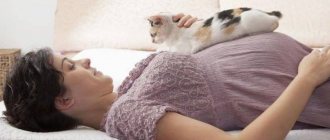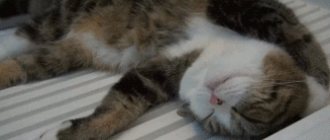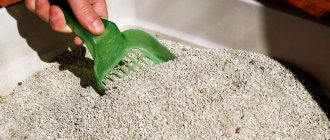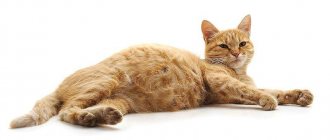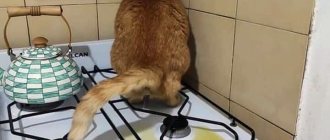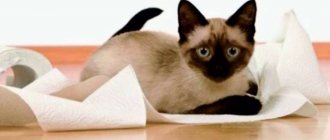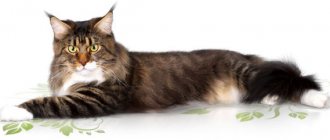Pregnancy in Maine Coons is longer than in other cat breeds. Therefore, kittens appear on average 7 - 10 days later than usual. How do the first signs of pregnancy appear and when should you expect babies? How to help the expectant mother and what complications may there be? What should a first aid kit consist of and what should be the place for childbirth? As well as advice on caring for a woman in labor.
First signs
The first signs of pregnancy appear approximately 3 weeks after the start of the last estrus. These include:
- Swelling of the cat's nipples (they become bright pink).
- Slight weight gain.
- No heat. The cat calms down and no longer asks for the cat.
- Changes in taste preferences (for example, the expectant mother begins to show interest in food to which she was previously indifferent, and vice versa).
There are no tests for feline pregnancy, but an interesting situation can be detected through ultrasound.
Progression by week
Veterinarians distinguish the following stages of pregnancy by week:
- 3 weeks after mating, the first signs appear.
- At 3–4 weeks, the cat develops toxicosis (due to hormonal changes). In this case, drowsiness occurs and appetite worsens.
- In the fifth week, the expectant mother noticeably gains weight. The cat's appetite improves and its belly becomes rounder. The pet becomes calmer and more affectionate.
- At 6 - 8 weeks, kittens begin to move (this can be noticed when observing the pet). Maine-kunsha becomes anxious and tries to find a secluded place to give birth.
- The ninth and part of the tenth week is the last period of gestation. The pet loses its appetite and begins to actively lick its belly and vulva.
During the period of contractions, the cat rushes about in search of a suitable place and meows loudly, attracting the owner’s attention and demanding help and care from him. This period lasts about a day, after which labor begins.
When are we expecting babies and how many will there be?
A pregnant cat lasts an average of 9 - 10 weeks (or 70 - 72 days).
Moreover, the duration of gestation greatly depends on the number of kittens in the litter.
The more there are, the sooner they will be born (in order to reduce the load on the body, the cat gives birth faster).
Babies born before the 62nd day have poor health and therefore require special care (otherwise they risk not surviving). In Maine Coons, the number of kittens in a litter is approximately 4 - 6, but there are cases where cats of this breed carried 10 kittens.
It is not recommended to feel the belly of a expectant mother in order to determine the number of fetuses in the womb, since it is possible to damage the vital organs of the cat - the mother or the offspring she is carrying.
Pedigree feed lines
The rating of special breed feeds includes the following brands:
- Royal Canin Maine Coon;
- Brit Care Tobby I'm a Large Cat;
- Carnilove for Large breed cats (suitable for cats with allergies);
- Flatazor Crocktail Adult Large Breed;
- Leonardo Adult Maxi;
- Nature's Protection Superior Care Large Cat.
The advantages of each brand can be clarified with a veterinarian, Maine Coon breeders, or in video reviews of Royal Canin and Hills food.
Help for the expectant mother
The appropriate age for the first pregnancy is 8 - 10 months.
It is during this period (not earlier) that the pet is physically and hormonally ready to become a mother.
The correct course of pregnancy and appropriate care will help not only to avoid complications in the process of bearing kittens and subsequent births, but also to maintain the health of the cat.
It is advisable to start taking care of the animal even before mating with a cat. Therefore, it is important for the owner to know the basics of proper pet care (food, rest, help during toxicosis).
For a beginning breeder: at what time can a cat become pregnant?
When a fluffy, uncastrated young beauty lives in the house, sooner or later the owner is puzzled by the question of what time the cat can become pregnant. Knowledge in the field of physiology, understanding of the characteristics of sexual behavior, and the nuances of reproduction will help you competently approach the problem of keeping and breeding a pet.
Age at which a cat can become pregnant
The cat family is distinguished by its early maturity and fertility. This is also true for pets. A number of factors will influence when a cat can become pregnant for the first time:
The average cat has her first heat, and with it the opportunity to become pregnant, occurs at 6 - 8 months. Later, large breeds and those with long coats mature. In representatives of such breeds as Maine Coon, bobtail, Siberian, Norwegian forest cat, the first heat occurs at 12 - 14 months. Short-haired breeds, as well as outbred animals, can mature before 6 months. Often the first heat is observed at the age of 4 - 5 months. This should be taken into account when keeping a young female in the house.
From the moment of the first heat, the pet is physiologically ready to become a mother and retains this ability for almost the entire adulthood. There is no such thing as menopause in the cat family. The reproductive period begins with the first heat and can last until death. Owners of furry pets should be aware of this feature in order to understand that the answer to the question of how many months a cat can become pregnant is quite simple - immediately after puberty.
When is the best time to meet a cat?
Despite the rapid puberty of the pet, there is no need to rush into mating. The onset of the first estrus only signals the physiological readiness of the organ
Toxicosis
The cause of toxicosis in cats is hormonal changes in the body, and in some cases, poor diet. Characteristic symptoms:
- Vomiting in the morning (has a light color and does not contain traces of blood or bile).
- Drowsiness and weakness.
- Increased nervousness.
- Decreased appetite.
- Unhealthy coat.
If you notice signs of toxicosis in a cat, you should not panic, because this is a normal physiological reaction to changes in hormonal levels. Toxicosis, as a rule, can be observed at 2 - 4 weeks of pregnancy, and it lasts on average about 10 days. Usually this condition does not require treatment and goes away on its own. But in case of prolonged toxicosis or significant deterioration of the condition, it is recommended to show the animal to a veterinarian.
Postpartum care
After the birth is over, it is necessary to examine the cat and feel her stomach to check that there are no kittens inside. If the kittens can be felt inside, you should wait, perhaps the cat will give birth to them a little later. If this does not happen within 24 hours, you should consult a specialist. If, upon examination, loss of coordination, excessive salivation, shortness of breath “like a dog” or convulsions were noticed, these may be signs of eclampsia - a sharp decrease in the level of calcium in the body after childbirth. This disease is quite common in animals that have just given birth and is very life-threatening, so it is necessary to carefully monitor the pet and if at least one of these signs appears, start sounding the alarm. Symptoms may not appear immediately, but within a week or two after birth, and the cat begins to behave strangely, move the kittens from place to place, take them out of the box, or treat them not very carefully. In this case, you need to give the cat sweet water or glucose solution and urgently call a doctor, because the sooner treatment begins, the greater the chances of recovery for the young mother. In addition to all of the above, it is very important to monitor the cat’s discharge in the first weeks after birth. The reason to call the veterinary clinic is the following nature of the discharge:
- severe bleeding that does not stop for more than 7-10 minutes;
- watery discharge with a sour odor;
- purulent discharge;
- green/gray discharge with a putrid odor.
Full recovery of a cat after giving birth lasts on average 21 days. During this period, the cat fully regains strength, health and is ready for a new conception, therefore, if you do not want another pregnancy, you must closely monitor the young mother or sterilize the cat. You can sterilize an animal no earlier than two months after birth and consult a specialist in advance, otherwise you can seriously harm its health.
Nutrition and vitamins
Proper nutrition during pregnancy plays an important role in the formation of future babies. Therefore, veterinarians advise feeding your cat a balanced diet (there are special product lines designed for pregnant women). In addition to the daily diet, you can give your furry pet vitamins (Doctor Zoo, Seva, Canina, etc.).
You should not combine fortified feed and vitamins, as this can lead to the development of vitamin deficiency.
Mixed feeding
Mixed nutrition includes primarily dry industrial food; natural products in this case serve as additional food. When feeding a Maine Coon in a balanced diet, meat products should not exceed 20%, otherwise the pet may get carried away. In this case, you will have to completely switch to natural food and independently calculate all the nutrients in the bowl, or the cat should eat only industrial food that does not require additional additives.
Selecting a location
The place for cat birth must be prepared in advance.
A large cardboard box is perfect for this purpose (approximate parameters: length and width at least 90 cm, height - 50 cm).
At the same time, one wall of the box needs to be trimmed a little so that it is convenient for the nursing mother to jump into the house (including so that she does not crush the kittens).
It is recommended to place soft bedding at the bottom of the box. During pregnancy, the cat needs to be introduced to the place for future birth. It is advisable to place the box in a quiet place where no one will disturb the mother and kittens.
First aid kit for feline birth
You should stock up on tools for your cat's first aid kit in advance. So, during childbirth you cannot do without the following devices:
- Alcohol for disinfection.
- Scissors.
- Disposable diapers (they can be purchased at a veterinarian's store or pharmacy).
- Soft cloths or napkins (may be needed for rubbing newborn kittens).
If the owner has not previously taken part in a cat’s birth and is afraid, you can call a veterinarian to your home for a fee.
Tips for caring for a new mother
The expectant mother requires special attention and special care. During this period, veterinarians recommend adhering to the following rules:
- Trim the hair around the pregnant woman's nipples (with scissors without sharp ends).
- A few weeks before giving birth, protect your pet from sudden movements.
- Spend more time with your cat (especially in the last days before the kittens are born).
- Do not take your pet on long trips.
- Provide your cat with healthy nutrition, peace and comfort.
- Give any medications only after consulting a veterinarian.
- After giving birth, keep the cat's house clean (change the bedding periodically).
- Monitor the color and consistency of your cat’s discharge during the postpartum period. Normally they have a reddish color, but after 4 - 6 days they acquire an increasingly lighter shade. If the cat is very weak, it is necessary to carefully remove discharge from the thighs and vulva using a damp towel.
- Provide the mother in labor with plenty of fluids.
- It is recommended to place bowls with food and water close to the cat's shelter.
- Do not let your pet go for walks during pregnancy and after giving birth (as she can pick up an infection from other cats and cats, and subsequently infect still immature kittens).
If a woman in labor appears weak, refuses to eat, body temperature rises to 38 - 39 degrees, or if the mammary glands become inflamed, consult a veterinarian immediately.
Possible situations
Usually cats give birth easily and quickly, but if the need for help arises, you can stimulate contractions and pushing by stroking the abdomen. When the kitten is born it is necessary to examine it. If the kitten was born in the amniotic sac, it must be removed: carefully pierce the sac with scissors or tear it apart with your fingers, and clean the mouth and nose with a pipette. Drag the umbilical cord 2-3 cm from the kitten’s belly with a thread and cut it off; you can wipe the baby’s face with a damp, clean cloth to finally remove mucus from the nose and eyes.
If a newborn has swallowed liquid, experienced breeders recommend taking it in your hand, firmly fixing it in a head-down position, carefully, without damaging it, cover it with your other hand and make two or three sharp movements, raising your outstretched arms up and sharply lowering it between your knees, as if splitting wood with an axe. This allows you to “shake out” the amniotic fluid from it. After which it is necessary to examine the oral cavity for clots, the presence of which makes it difficult for the baby to breathe. Such clots must be removed with any clean small object, such as a thin cotton swab.
There are situations when a cat has been pushing for quite a long time, but the kitten is in no hurry to be born. Perhaps the fetus is not positioned correctly in the birth canal. To help a cat in such a situation, you need to put on sterile gloves, lubricate the entrance to the vagina and your finger with something that can ensure easy penetration, such as Vaseline, and carefully insert your finger to feel the fetus. Try to understand by touch what position he is in, put your finger on his stomach and with each attempt of the cat help him move in the right direction. This manipulation must be carried out very carefully, any careless movement can harm both the cat and the kitten!
A similar situation is possible when two kittens pass through the birth canal at the same time. You can try the same way as in the previous case to solve the problem yourself, but it is better to use the help of a veterinarian.
Newborn kittens must be given to their mother for further licking and feeding. Unless absolutely necessary, try not to pick them up or touch them for the first weeks, otherwise the cat may stop caring for them.
Possible complications
In the absence of proper nutrition, in case of hypothermia or overheating of the body, if the cat is infected with pathogenic microorganisms, the following complications are possible:
- Miscarriage (usually occurs at 4–5 weeks of pregnancy). In this case, lifeless fetuses may remain in the uterus, which will cause putrefaction and inflammation of the internal genital organs. In this case, you cannot do without the help of a veterinarian.
- Bleeding. It occurs as a result of rupture of the cervix during childbirth: scarlet fluid flows profusely from the vulva, and the cat lies on its side with its tongue hanging out. In the absence of timely treatment, the animal may die.
- Mastitis (inflammation of the mammary glands as a result of excess milk). In this case, redness and soreness of the nipples are observed, and yellowish breast discharge appears. In this case, the cat is isolated from the kittens and special treatment is carried out.
- Metritis (inflammation of the uterus due to infection). In this case, the animal becomes apathetic, the body temperature rises, and there is abundant discharge from the vulva with an unpleasant odor.
- Insufficient amount of milk (occurs, for example, with a large number of kittens, with a lack of adequate nutrition or fluid).
